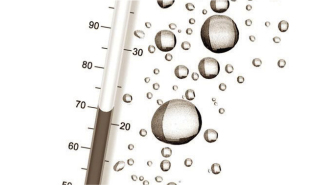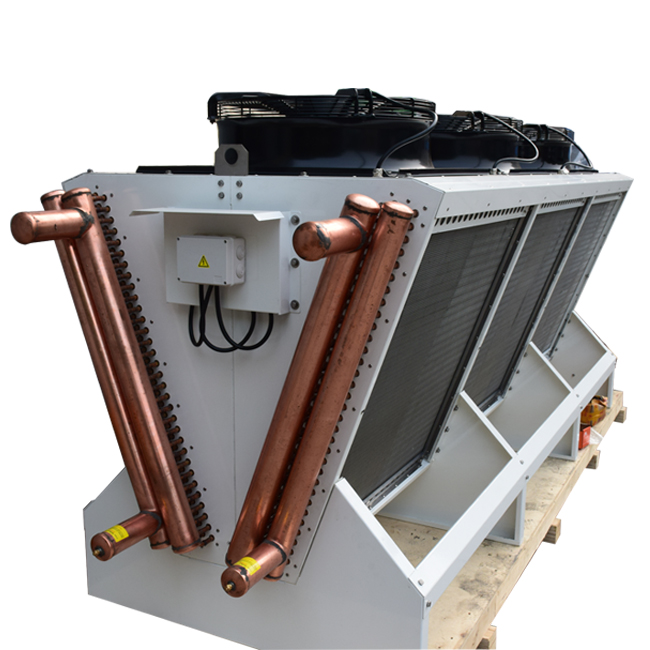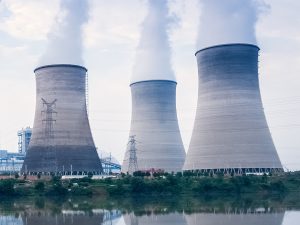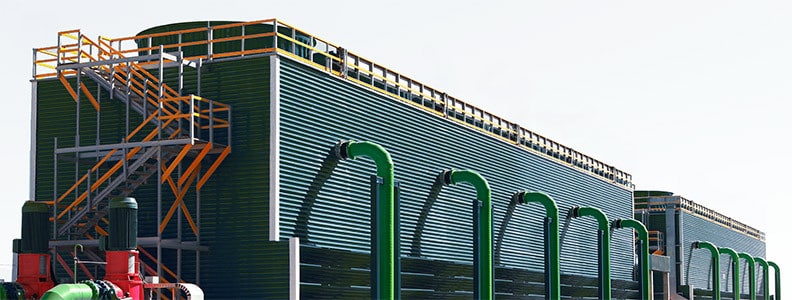Free cooling solutions that use natural cool air or water instead of mechanical refrigeration are appealing for data centers looking to save electricity. Selecting a suitable free cooling system is influenced by factors such as the highest operating temperature for the servers and water availability. Dry air coolers, adiabatic coolers, and cooling towers are examples of heat rejection devices.
This article compares these solutions in both a generic and a local context.
Free Cooling
The removal of heat from a process without the use of mechanical refrigeration is known as free cooling. When the ambient temperature is lower than the desired return air temperature, free cooling becomes a possibility (minus a few additional degrees for efficiency losses, known as the approach temperature). Free cooling is quantified in hours per year. It is directly tied to your process temperatures and is known as free cooling potential. Regions with greater average ambient temperatures have less free cooling potential than those with a colder environment.
Adjusting your data center operating temperatures to a higher level is one way to increase your hours of free cooling potential. This will increase the number of hours per year where the temperature is below your return air temperature and, as a result, chiller system operation hours will be reduced.

Standard Temperature
The temperature difference between the process media and the heat transfer medium flowing through a heat exchanger determines its performance. In the case of a data center the heat transfer media would generally be chilled water, and the process media, the server exhaust air.
The temperature difference between the process water and the ambient air passing through the heat exchanger in dry coolers means that the performance of a dry cooler is directly influenced by the atmosphere’s Dry Bulb temperature.
Cooling towers, on the other hand, rely on the Wet Bulb temperature. Wet Bulb temperatures are lower than the ambient air’s dry-bulb temperature and are proportional to humidity; when humidity rises, the wet-bulb temperature rises as well.
Using an adiabatic system to reduce the temperature of the air within the heat exchanger by spraying water into the ambient air to enhance humidity is one technique to improve a dry air cooler. This works because increasing the humidity in the air lowers the dry bulb temperature. Adiabatic dry coolers can offset high ambient temperatures all year round, improving a site’s free cooling potential.
Factors In Choosing Heat Rejection Technologies
Water & Evaporation Availability
The availability of water on-site, as well as the possibility of evaporation in the ambient air, are important considerations for choosing heat rejection methods.
Cooling towers are a reasonable solution for big sites where water is abundant, due to their heat rejection capability and availability of free cooling.
As the humidity in the region rises, this option becomes less appealing because high humidity reduces the number of annual operational hours where a chiller is not necessary. This is also true for all technologies that rely on evaporation, such as augmented and adiabatic systems.
Water Quality & Treatment
Cooling towers and adiabatic coolers can utilize potable water, city water, spring water, or even rainwater. However, the quality or degree of contamination is critical for all forms of water.
Values for total suspended solids (TSS) or total dissolved solids (TDS), such as salts, are important considerations. These factors influence the selection of the proper fill for cooling towers. A coarser-meshed packing is used where water contamination is greater, which affects performance.
To avoid corrosion and mineral deposits, it’s critical to utilize clear water with low mineral content (soft water). Higher mineral content water (hard water) can be used with a pad system.
Water treatment can adapt water quality to the adiabatic system. This can be accomplished through filtration and/or chemical treatment. These considerations have an impact on the materials used, the size and performance of heat exchangers, and consequently their overall cost. As a result, to develop the most efficient heat dissipation solution, all aspects of the total system must be considered.
PUE VS WUE
When it comes to the performance of heat rejection equipment, there is a strong correlation between the two metrics of PUE and WUE.
Dry air coolers, which have little influence on WUE but a large impact on PUE, are on one end of the range, while cooling towers, which have a comparatively low impact on PUE but a big impact on WUE, are on the other.
Technologies like adiabatic and enhanced dry coolers, as well as other bridging technologies, are in the middle, lowering PUE at the expense of WUE and vice versa.
Although there are a variety of approaches to improve efficiency, advances in PUE typically come at the expense of WUE.
Advantages Of Technology For Different Conditions
Data center cooling systems have an impact on operating costs and resource use. These usually rise in tandem with increased ambient temperatures. When choosing your system, it’s critical to build yearly models for operation. This will prove an impact on your operating expense (OpEx), and ensure the design is efficient for year round use. There is a capital expenditure (CapEx) for the free cooling system, and so the total number of days or hours of free cooling per year will determine how quickly there is a return on investment (ROI).
Dry coolers, adiabatic coolers, and cooling towers are all heat exchangers that transfer process heat from a liquid medium to the surrounding air. Nonetheless, there are variances in the technology and, as a result, various benefits.
Dry coolers transfer energy by heating the surrounding air, necessitating a large volume of airflow. To dissipate the energy, cooling towers evaporate water, resulting in high water consumption but low air volume requirements.
Adiabatic coolers do not rely on evaporating water to dissipate heat. They just chill the surrounding air. The energy exchange is similar to that of dry coolers, but when ambient temperatures are too high for dry air chilling, water is necessary.
The wet-bulb temperature must be used for adiabatic coolers and cooling towers since it is influenced by air temperature and humidity. As a result, analyzing local weather data to determine the link between temperature and humidity is critical.
Cooling towers and adiabatic heat exchangers, as previously stated, are far more dependent on weather conditions. Changes in humidity, in addition to temperature, have an impact on the heat dissipation of the equipment. High air temperatures combined with low wet-bulb temperatures allow cooling towers to work efficiently, resulting in low return temperatures.

Example of Dry Cooler
- V-Bank has a small footprint and a high capacity density.
An adiabatic cooler may be a good compromise between the two approaches. It functions as a dry chiller at low temperatures while evaporation of water is utilized to boost efficiency at high temperatures and low relative humidity. An adiabatic cooler expands the range of applications for a dry cooler, allowing for the mitigation of hot but dry ambient conditions and hence more efficient operation. However, unlike cooling towers, adiabatic coolers do not achieve the same return temperatures. The temperature is always a few degrees higher.
Throughout the year, the dry cooler is excellent for applications where the ambient temperature is lower than the desired return temperature. It’s also good for places with high humidity or where there’s no water.
The cooling tower is the ideal companion for these working conditions, achieving the lowest return temperatures with the highest efficiency.=
All heat rejection methods can reduce their power usage by adjusting fan speeds with EC fans or inverter drives as ambient temperatures drop by lowering fan speed as the temperature differential between process and ambient rises throughout the year.
Function Adiabatic Cooler
- The entering air is cooled using the evaporating energy of water.
- Spray nozzles that consume less water and produce smaller droplets have been developed.
- As a result, with the same temperature cooling effect, 39 percent less water is used.
- The system is set up to evaporate 95% of the water in the air rather than on the coil. This helps to prevent coil fouling and corrosion.
- The entering air is cooled using the evaporating energy of water.
- On top of the pad, a newly built water distribution system integrates standard systems to better utilize the respective advantages.
- The technique allows for consistent air cooling while minimizing water loss.
- Pads can be easily removed and reinstalled for periodic inspection and cleaning.
- Depending on the situation, optional meshes in front of the pad defend against dirt and debris.
The “wet fin effect” occurs when a portion of the water directly evaporates on the fins. This improves the dry cooler’s adiabatic chilling effect as well as heat transmission. Spray systems, on the other hand, might raise the danger of corrosion when used for lengthy periods.
In front of the cooler, pad systems are installed. Although the adiabatic air cooling effect is relatively large, it results in a year-round airside pressure loss.
The waste heat from server rooms can be ejected into the atmosphere via cooling towers. They come in cross-flow and counter-flow configurations and can provide cost-effective free cooling. Cooling towers can be installed completely completed, whether modular or field erected, saving downtime on replacement projects and congestion on new construction sites.
A dry cooling technique is the greatest alternative when water is scarce. Adiabatic heat rejection, on the other hand, is gaining popularity. For the most part, adiabatic coolers employ fans to reject heat and feature a water spray system that only operates when the ambient temperature is extremely high.
As a result, they consume far less water and have lower operating expenses than typical cooling towers.
Function Cooling Tower

Photo Credit: www.hygiena.com
- Water flows downward, while a fan draws air upward.
- Counterflow cooling towers can successfully reach the wet-bulb temperature.
- The evaporation of around 1% of the circulating water provides cooling.
- Over the surface of plastic fills, direct contact between water and ambient air is produced.
- Warm water flowing down via a cooling unit is cooled by air pulled above by a fan.
- The temperature drops quickly due to evaporation and direct heat exchange.
- Induced draught crossflow cooling towers are much quieter and smaller than counterflow cooling towers.
Current Climate Trends
Refrigeration and heating systems are frequently used for over 20 years. This raises the question of what our climate will look like in the future. We can find trends and draw judgments about what to expect by going back over the last 40 years.
We calculated the potential for free cooling each year using weather data for this purpose. For the sample computation, a water return temperature of 26°C was employed. This refers to how often the air temperature falls below 24°C in dry coolers.
We assumed a 70% efficiency for the adiabatic system and a maximum wet bulb temperature of 24°C for cooling towers.
These trends are depicted in the graphs above for various technologies. This, however, just examines temperatures. However, there are other factors to consider, including selecting the best solution in terms of space, water, and evaporation supply, efficiency, and the overall system and total cost of ownership.
Climate change and rising temperatures can be seen in many parts of the world. In the case of dry coolers, we see a polynomial mixer in Frankfurt and Beijing, when we still see a linear trend line for Dallas.
In Frankfurt, for example, 90 to 95 percent free cooling was predicted in the 1980s, and this was still the case 22 years later, in 2002. However, we can observe the impact of global warming if we look at the last two years – 2018 = 81.6 percent and 2019 = 82.4 percent.
Dry coolers can be sized to counteract this trend using modern technology like efficient tube and fin systems and efficient EC fans. Dry coolers can be used almost anywhere in the world all year, which necessitates further thought.
A recent technology trend is adiabatic heat exchangers. As you can see from the graphs, free cooling is beneficial. However, this technology has its limitations.
You can see how the trend has been declining in Frankfurt and Dallas since around 2005. As a result, the long-term trend of the world average is anticipated to be negative. Beijing, on the other hand, demonstrates that there are regional variances. Since the 1990s, the number of cooling towers and adiabatic heat exchangers in Beijing has increased slightly. We’re only considering this from the standpoint of temperature. Spray or pad systems can be added to adiabatic coolers to customize the technology to your specific needs.
Because we set the adiabatic at 70% of the prevailing wet-bulb temperature, the cooling tower trend line looks a lot like the adiabatic curve. However, depending on the locality, cooling towers can freely cool 3-5 °C at greater temperatures. The correct cooling tower model and materials are dependent on water quality and availability, as well as geographical factors.
Cooling towers or adiabatic heat exchangers can be a solution for places with specific ambient conditions, according to our calculations. Dry coolers are still an effective solution in colder climates or in areas where water is scarce. All heat rejection systems have the potential to boost free cooling and consequently energy efficiency.
On a worldwide scale, however, we anticipate a worsening of climate conditions for these gadgets. As a result, we urge that these negative trends be factored into the equipment design, as well as planning for higher temperatures, to maintain a long-term efficient operation. Local weather phenomena should be considered for undertakings that are not geographically bound. Climate change will make some locations more appealing than others in terms of climate.
Some Tips To Consider For Sustainable Performance of Heat Rejection Methods
- Ensure that the equipment is properly maintained.
- IoT performance monitoring has a lot of potentials.
- By avoiding maximum speeds for point of selection, you’ll have some buffer time in case of changing conditions or peaks.
- To combat changing air quality, consider applying surface coatings.
- If conditions change, consider retrofitting adiabatic systems.
- Maintain a supply of spare parts.
- Include your HX partner in the planning process to explore indirect redundancy or future-proofing two circuit systems (cold-warm-system).
Conclusion
Free cooling for your data center is a cost-effective solution to lower your electrical chiller’s load ratio and hence lower cooling energy consumption.
The best heat rejection solution is determined by several factors, including ambient temperatures, water availability, and the general design of your data center.
Reference Links:
https://hvac-eng.com/datacenter-liquid-cooling-methods/
https://www.datacenterdynamics.com/en/opinions/back-basics-rethinking-data-center-cooling/





